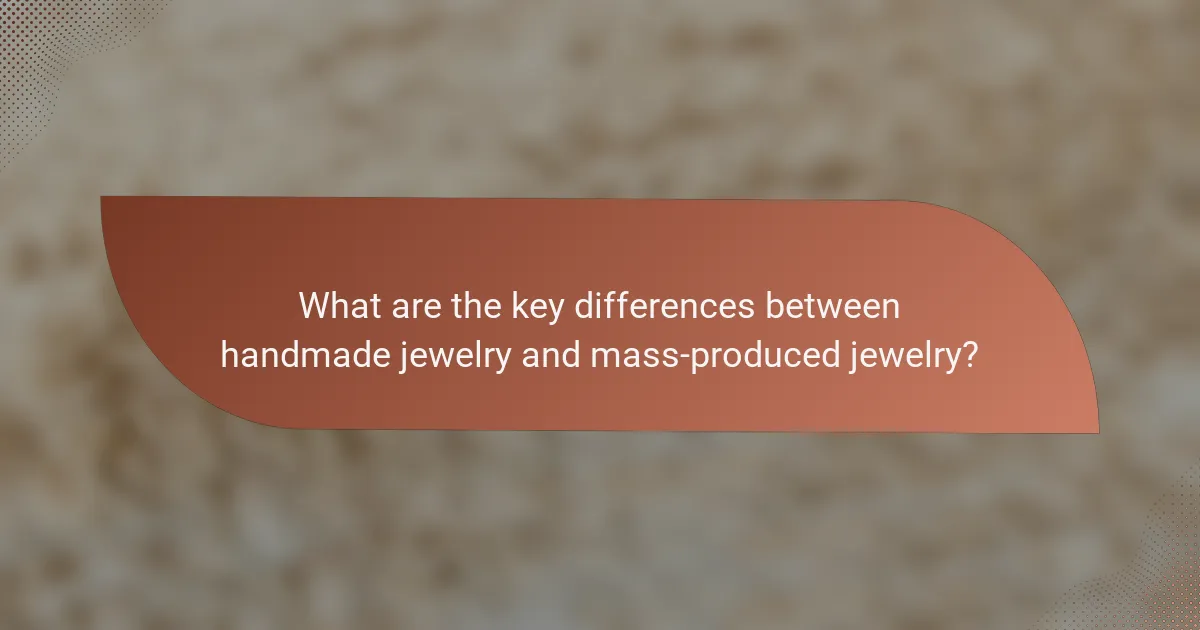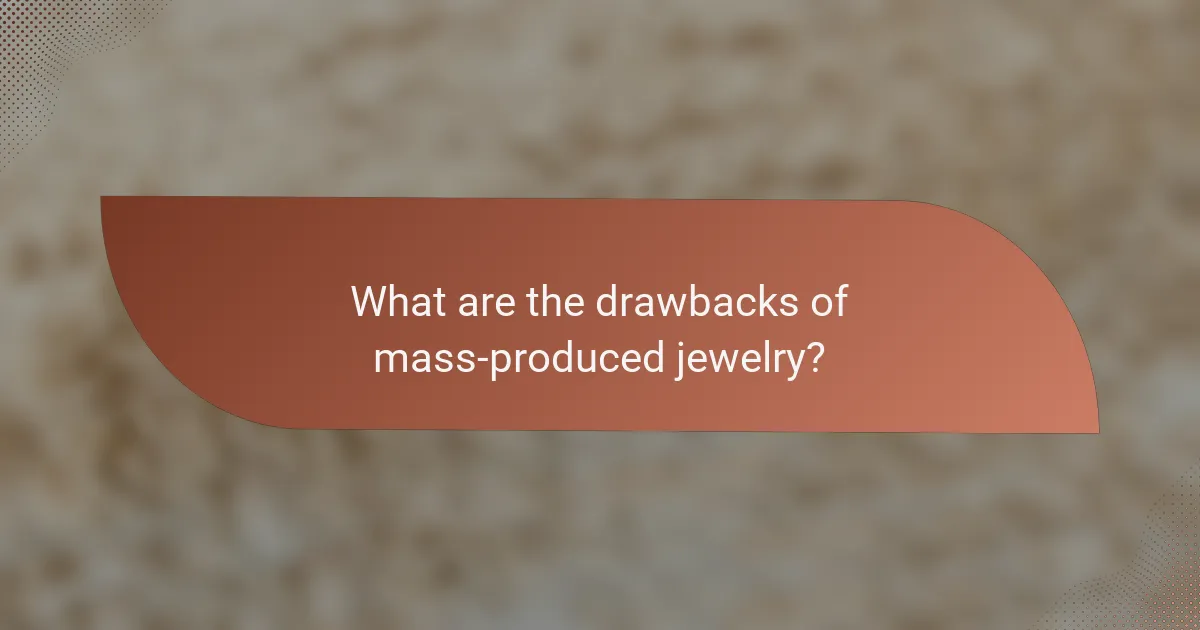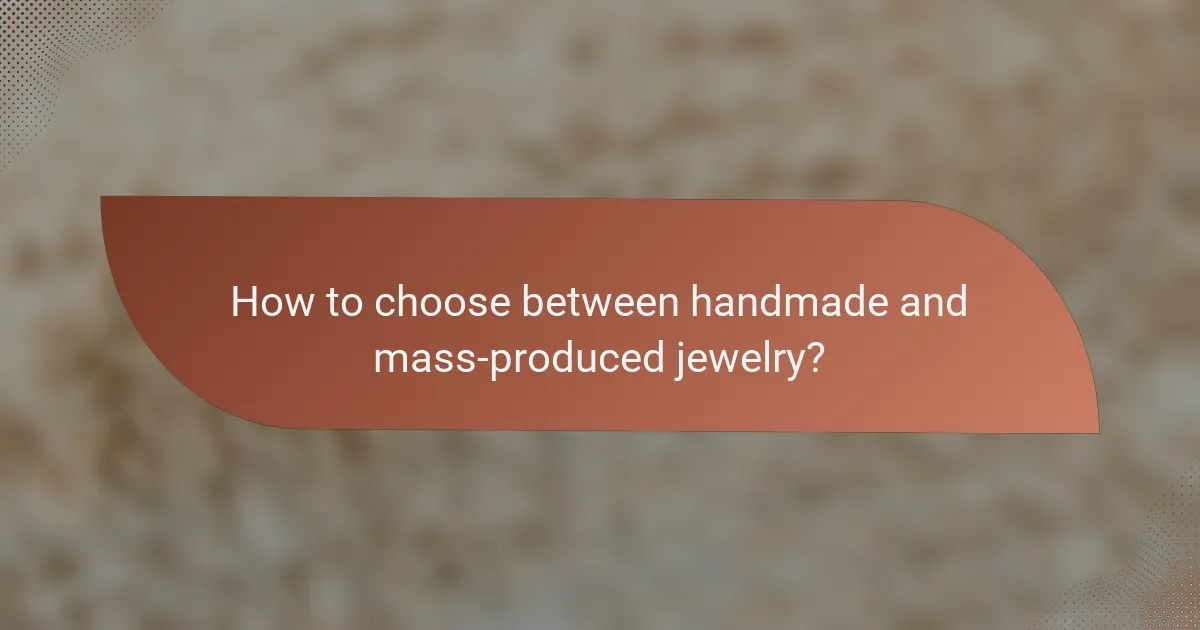The debate between handmade jewelry and mass-produced alternatives highlights significant differences in value, quality, and craftsmanship. Handmade jewelry is crafted with care by skilled artisans, resulting in unique pieces that often carry a higher price due to their labor-intensive creation process. In contrast, mass-produced jewelry benefits from efficiency and lower costs but lacks the individuality and artistry found in handmade items.

What are the key differences between handmade jewelry and mass-produced jewelry?
Handmade jewelry is crafted individually by artisans, while mass-produced jewelry is manufactured in large quantities using automated processes. The key differences lie in craftsmanship quality, material sourcing, design uniqueness, production time, and environmental impact.
Craftsmanship quality
Handmade jewelry typically exhibits superior craftsmanship as it is created with meticulous attention to detail by skilled artisans. Each piece is often unique, showcasing the maker’s personal touch and artistic vision. In contrast, mass-produced jewelry may lack this level of detail, as it is made to meet uniform standards and efficiency rather than individual artistry.
Material sourcing
Artisans who create handmade jewelry often prioritize high-quality, ethically sourced materials, such as precious metals and gemstones. They may select materials based on their origin and sustainability. Mass-produced jewelry, however, frequently relies on lower-cost materials to maximize profit margins, which can lead to less transparency regarding sourcing practices.
Design uniqueness
Handmade jewelry often features one-of-a-kind designs that reflect the creator’s style and creativity, making each piece special. Customers looking for something distinctive will find handmade options more appealing. Mass-produced jewelry, on the other hand, tends to follow trends and popular designs, resulting in a lack of originality and a more generic aesthetic.
Production time
The production time for handmade jewelry can vary significantly, often taking days or even weeks to complete a single piece due to the labor-intensive process involved. This contrasts with mass-produced jewelry, which can be manufactured in bulk within a matter of hours or days, allowing for rapid availability and lower prices.
Environmental impact
Handmade jewelry often has a lower environmental impact, as artisans may use sustainable practices and local materials, reducing transportation emissions. In contrast, mass-produced jewelry can contribute to significant environmental degradation due to industrial manufacturing processes and the use of non-renewable resources. Consumers concerned about sustainability may prefer handmade options for this reason.

How does pricing compare between handmade and mass-produced jewelry?
Handmade jewelry typically costs more than mass-produced pieces due to the labor-intensive processes and unique craftsmanship involved. While mass-produced jewelry benefits from economies of scale, handmade items often reflect the artisan’s skill and creativity, which can justify their higher price point.
Cost factors for handmade jewelry
The pricing of handmade jewelry is influenced by several factors, including the quality of materials, the time spent on creation, and the artisan’s expertise. Artisans often use high-quality gemstones and metals, which can significantly increase costs. Additionally, the intricate designs and personalized touches add to the labor involved, further raising the price.
For example, a handmade silver ring with a unique design might range from $50 to several hundred dollars, depending on the intricacy and materials used. Consumers are often willing to pay a premium for the story and individuality behind each piece.
Cost factors for mass-produced jewelry
Mass-produced jewelry is generally cheaper due to the use of automated processes and lower-quality materials. Manufacturers can produce large quantities at a reduced cost, allowing them to sell items at lower prices. This often results in jewelry that lacks the uniqueness and craftsmanship found in handmade pieces.
For instance, a mass-produced necklace might retail for as little as $10 to $50, primarily because it is made from less expensive materials and produced in bulk. The trade-off is often a lack of distinctiveness and personal connection to the piece.
Price perception among consumers
Consumers often perceive handmade jewelry as more valuable due to its uniqueness and the craftsmanship involved. This perception can lead to a willingness to pay higher prices, especially among those who appreciate artistry and personal stories behind the pieces. Handmade jewelry is often seen as a thoughtful gift or a personal statement.
In contrast, mass-produced jewelry may be viewed as more accessible and practical, appealing to budget-conscious shoppers. However, some consumers may also see it as less desirable due to its lack of individuality. Understanding these perceptions can help buyers make informed choices based on their values and preferences.

What are the benefits of choosing handmade jewelry?
Choosing handmade jewelry offers unique advantages that enhance value, quality, and craftsmanship. Handmade pieces often reflect the artisan’s skill and creativity, resulting in distinctive items that stand out from mass-produced alternatives.
Personalization options
Handmade jewelry frequently provides extensive personalization options, allowing customers to tailor designs to their preferences. This can include selecting specific materials, colors, and even custom engravings, making each piece truly one-of-a-kind.
Artisans often work closely with clients to create bespoke items that reflect personal stories or milestones, enhancing emotional value. This level of customization is rarely available with mass-produced jewelry, which typically offers limited choices.
Support for artisans
Purchasing handmade jewelry directly supports artisans and small businesses, fostering local economies and craftsmanship. By choosing handmade, consumers contribute to the livelihood of skilled makers, ensuring traditional techniques and artistry are preserved.
Supporting artisans also encourages sustainable practices, as many handmade jewelers prioritize ethical sourcing and environmentally friendly materials. This contrasts with mass production, which often relies on less sustainable practices.
Higher resale value
Handmade jewelry often holds a higher resale value compared to mass-produced items due to its uniqueness and craftsmanship. Collectors and enthusiasts are typically willing to pay a premium for distinctive pieces that tell a story or showcase exceptional artistry.
Factors such as the reputation of the artisan, the quality of materials used, and the rarity of the design can significantly influence resale potential. In contrast, mass-produced jewelry tends to depreciate quickly, making it less desirable in the resale market.

What are the drawbacks of handmade jewelry?
Handmade jewelry often comes with several drawbacks that can affect buyers’ decisions. These include higher costs, limited stock, and longer shipping times compared to mass-produced options.
Higher price point
Handmade jewelry typically has a higher price point due to the labor-intensive processes and unique materials involved. Prices can vary widely, often ranging from low tens to several hundred dollars, depending on the complexity and craftsmanship.
When considering handmade pieces, it’s essential to evaluate the quality and artistry behind the design. Investing in a unique item can be worthwhile if it aligns with your personal style and values.
Limited availability
Limited availability is a common drawback of handmade jewelry, as artisans often produce items in small batches or even as one-of-a-kind pieces. This scarcity can make it challenging to find specific designs or styles, especially if you’re looking for something unique.
To mitigate this issue, consider following your favorite artisans on social media or subscribing to their newsletters for updates on new collections. This way, you can stay informed about restocks and exclusive releases.
Longer delivery times
Longer delivery times are often associated with handmade jewelry due to the time required for crafting and shipping. While mass-produced items may ship within days, handmade pieces can take several weeks to arrive, depending on the artisan’s workload and shipping methods.
When ordering handmade jewelry, it’s wise to plan ahead, especially for special occasions. Always check the estimated delivery times before making a purchase to avoid disappointment.

What are the drawbacks of mass-produced jewelry?
Mass-produced jewelry often lacks the quality and craftsmanship found in handmade pieces, leading to several drawbacks. These can include lower quality materials, a lack of uniqueness, and various ethical concerns associated with production practices.
Lower quality materials
Mass-produced jewelry typically uses lower quality materials to keep costs down and maximize profits. Common materials include cheap metals and synthetic stones that may not withstand daily wear. In contrast, handmade jewelry often features higher-grade materials like sterling silver, gold, or genuine gemstones, which enhance durability and appearance.
When purchasing mass-produced items, consider checking for material specifications. Look for indicators such as metal purity or gemstone authenticity to gauge quality. Opting for handmade pieces can often ensure better material integrity.
Lack of uniqueness
One significant drawback of mass-produced jewelry is its lack of uniqueness. These items are often made in large quantities, meaning many people may own the same piece. This can diminish the personal connection and individuality that jewelry often represents.
Handmade jewelry, on the other hand, is typically crafted in limited quantities, allowing for unique designs that reflect personal style. If you value exclusivity, consider seeking out artisans or small businesses that offer one-of-a-kind pieces.
Ethical concerns
Mass-produced jewelry can raise ethical concerns related to labor practices and environmental impact. Many large manufacturers may prioritize profit over fair labor conditions, leading to exploitation of workers. Additionally, mass production often involves processes that can harm the environment.
To address these concerns, look for brands that emphasize ethical sourcing and sustainable practices. Supporting handmade jewelry from local artisans can often ensure that your purchase contributes positively to communities and the environment.

How to choose between handmade and mass-produced jewelry?
Choosing between handmade and mass-produced jewelry involves considering factors like value, quality, and craftsmanship. Handmade pieces often offer unique designs and superior craftsmanship, while mass-produced items typically provide affordability and consistency.
Value comparison
The value of handmade jewelry often lies in its uniqueness and the artisan’s skill. These pieces can be more expensive due to the time and effort invested in their creation. In contrast, mass-produced jewelry is generally more affordable, making it accessible to a broader audience.
When assessing value, consider what you prioritize: a one-of-a-kind item that reflects personal style or a budget-friendly option that meets basic needs. Handmade jewelry can appreciate over time, while mass-produced items may not hold their value as well.
Quality differences
Handmade jewelry typically boasts higher quality materials and craftsmanship. Artisans often use superior metals and stones, ensuring durability and aesthetic appeal. Mass-produced jewelry, however, may rely on lower-quality materials to keep costs down.
Inspecting the finish and detailing can reveal quality differences. Handmade pieces often have intricate designs and a polished look, while mass-produced items may show signs of rushed production, such as rough edges or inconsistent finishes.
Craftsmanship insights
Craftsmanship in handmade jewelry is characterized by attention to detail and personalized techniques. Each piece is often crafted with care, reflecting the artisan’s unique style and expertise. Mass-produced jewelry, on the other hand, is manufactured using machines, which can lead to uniformity but may lack the personal touch.
When evaluating craftsmanship, look for signs of handwork, such as soldering marks or unique design elements. These features can indicate a piece’s handmade origin and the skill involved in its creation.
